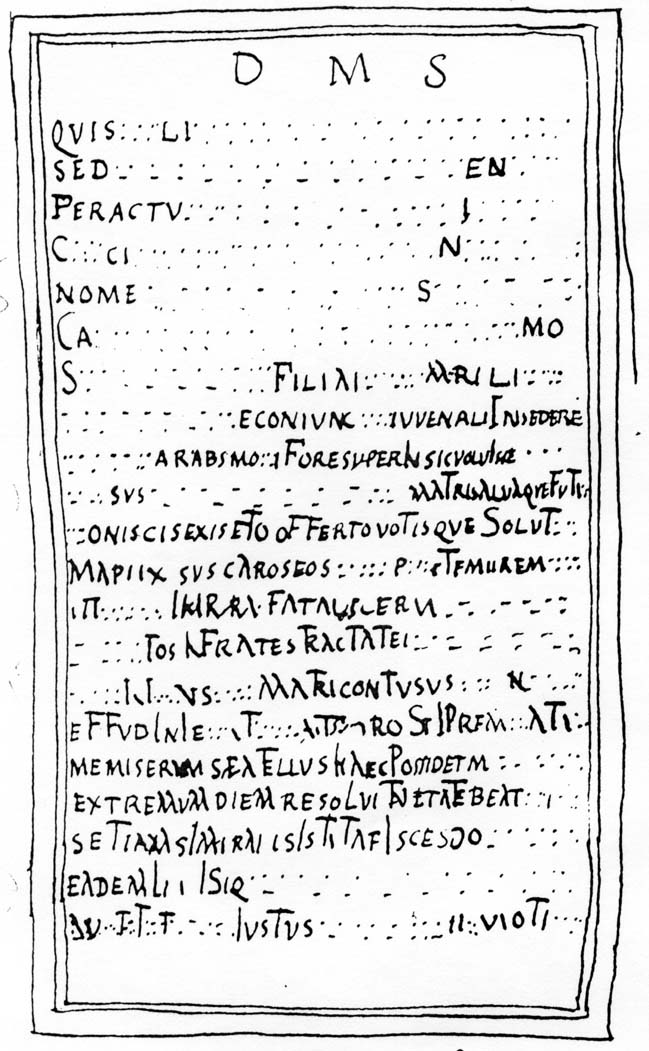Funerary inscription
Reference CIL II2/7, 121 | Description | Lyrics | Location | Chronology | Epigraphic edition | Translation | Apparatus | Comentary | Type of verse | Text divided into verses and metric signs | Images | Bibliography | Link to DB | Author |
Funerary inscription
Description
- Idno filename 22/01/0039
- Type of inscription: Sepulcralis
-
Epigraphic field:
- Layout: Inscription in poor condition, maltratada JIMENA.
- Lost
Location
- Place of discovery: Found in Porcuna (Obulcone), Jaén.
- Geolocation
- Location with Modern Nomenclature España / Jaén / Porcuna
- Location with Old Nomenclature Hispania / Baetica / Cordubensis / Obulcone
Chronology
- Inscription's dating: Between year 101 and year 199
- Dating explanation: GONZÁLEZ ROMÁN proposes the 2nd c. AD in view of the form of the letters of the transcription, a piece of data which should be treated with caution, although the formula of consecration to the Manes does fit this dating (vid. STYLOW 1995, 223).
Type of verse
- Type of verse: Dactílico (ritmo)
- Verse/line correspondence: Si
- Prose/verse distinction: No
Epigraphic edition
D(is) M(anibus) s(acrum)
Quis [‑ ‑ ‑]LI[‑ ‑ ‑]
Sed [‑ ‑ ‑]EN[‑ ‑ ‑]
Peractu[‑ ‑ ‑]I[‑ ‑ ‑]
5 C[‑ ‑ ‑]CI[‑ ‑ ‑]N[‑ ‑ ‑]
Nome[n ‑ ‑ ‑]S[‑ ‑ ‑]
Ca[‑ ‑ ‑]MO[‑ ‑ ‑]
S[‑ ‑ ‑] filiae [‑ ‑ ‑] m · ri LI[‑ ‑ ‑]
[‑ ‑ ‑]E coniu⁽nx⁾ [‑ ‑ ‑] iuvenali ìnsedere
10 [‑ ‑ ‑]ARABSMO[‑ ‑ ‑]I fore super ⁽in⁾ sic vol⁽uì⁾sse [‑ ‑ ‑]
[‑ ‑ ‑]SVS[‑ ‑ ‑] matri salvaque fu<it>
[‑ ‑ ‑]ONISCISEXISETO offerto votisque solut[‑ ‑ ‑]
MAPIIX SVS CAROSEOS[‑ ‑ ‑]P[‑ ‑ ‑] TEMVREM[‑ ‑ ‑]
+ + [‑ ‑ ‑] IMRR ≈ fatalis + ER+ [‑ ‑ ‑
15 [‑ ‑ ‑]TOS ⁽inf⁾rat<r>es ⁽tr⁾actatei [‑ ‑ ‑]
[‑ ‑ ‑] + + [‑ ‑ ‑]VS[‑ ‑ ‑] ma⁽tr⁾i contusus [‑ ‑ ‑]N[‑ ‑ ‑]
effudì NÌE[‑ ‑ ‑]+T[‑ ‑ ‑]AT++RO ⁽su⁾+prem[‑ ‑ ‑]ATI[‑ ‑ ‑]
me miserum s+e+ ⁽te⁾llus haec possidet M[‑ ‑ ‑]
extremum diem resolvi⁽t<a>⁾eta⁽te⁾ beat[a‑ ‑ ‑]
20 set iam sì miraris ìs⁽ta⁾TAFÌSCESDO[‑ ‑ ‑]
eadem Ì++[‑ ‑ ‑]ÌSIQ[‑ ‑ ‑]
+ +[‑ ‑ ‑]Ì+T+T[‑ ‑ ‑] ìustus [‑ ‑ ‑]+ + VIOTI
Text divided into verses and metric signs
Quis [‑ ‑ ‑]
Sed [‑ ‑ ‑]
Peractu[‑ ‑]
[- – – – – -]
5 Nome[n ‑ ‑ -]
Ca[‑ ‑ ‑]
[‑ ‑ ‑] filiae [‑ ‑ ‑]m rili[‑ ‑ ‑]
[‑ ‑ ‑]e coniunx [‑ ‑ ‑] iuvenali insedere [ln]|x/l|l/[n|l]/kk|llk|l~
[‑ ‑ ‑]i fore super in sic voluisse [‑ ‑ ‑] xkkkkl|lkk|lk[k|l~?]
10 [‑ ‑ ‑] matri salvaque fu<it> […]/l|ll|xkk|~
[‑ ‑ ‑] offerto votisque solut[‑ ‑ ‑] [ln|ln]|ll|l/l|lkk|l[~]
[- – – – – -]
[- – -] fatalis [‑ ‑ ‑]
[‑ ‑ ‑]tos in frat<r>es tractatei [‑ ‑ ‑]
15 [‑ ‑ ‑] matri contusus [‑ ‑ ‑] [ln|ln|l]/l|l/l|lk[k|l~]?
effudi [‑ ‑ ‑] su[-]prem[‑ ‑ ‑] ll|x[…]
me miserum s[-]e[-] tellus haec possidet m[‑ ‑ ‑] lkk|l/[l|l]/l|l/l|lkl|[l~]?
extremum diem resolu͡it aetate beat[a] ll|l/k|l/kk|l/l|lkk|l[~]
set iam si miraris ista[‑ ‑ ‑] ll|ll|lk||lk[k|lkk|~]?
20 e͡adem i[‑ ‑ ‑]
[‑ ‑ ‑] iustus [‑ ‑ -]
Translation
“Consecrated to the Manes: ... fulfilled ... the name ... to my daughter ... to my mother ... to my young wife ... the gods willed it so ... and saved for the mother ... vows that were offered and fulfilled ... struck ... spills? ... but woe is me, possessed by this earth ... after a happy life, he spent his last day ... but if you look with wonder ... the same ... just ...”
Bibliography
Jimena ms. 1639, 33v, cum. im. del. (inde Cabezón 1964, 140–141 [AE 1965, 95]; Vives, ILER 5821; González Fernández, CILA III, 327; Thigpen 1995, app. 3, 5; González Román, II2/7, 121); Cugusi 2012, 155. – Cf. Hernández Pérez 2001a, 317; Martín Camacho, CLEB ES, J2, qui in linguam Hispanicam vertit.
Apparatus
8 matri González Román. – 9 coniung González Román; 11 futi Jimena. – 15 + frates González Román. – 17 suprem González Román. – 18 sed González Román.
Comentary
From the individual sequences it can be stated that it is composed in dactylics (with some deficiencies): l. 9, iuvenali ìnsedere (kk|ll|lkk; l. 12: offerto votisque solut (ll|ll|lkk|l); l. 18, me miserum s+e+ tellus haec possidet (lkk|ll|lk|ll|kl); l. 19, extremum diem resolvit aetate beat[a —] (lllklklkllkk). Cabezón suggests that it is the epitaph of a gladiator based on the interpretation of fratres tractatei (l. 15) as “comrades” and iustus (l. 22) as “obeying the rules of the competition”, though with no weighty arguments (vid. Martín Camacho 2010, 135). L. 2, peractu[- – -], probably indicates the moment of death with a syntagma like vitam / aetatem perago (cf. CLE 394, 1; CLE 172, 4; etc.). Ll. 8, 9 and 11 refer to family life; l. 10, fore super^in sic voluisse may be part of the funerary topos that the gods had willed this death (cf. CLE 387, 6; CLE 509, 3, etc).
Author
- Author:J. Martín Camacho
- Last Update2024-02-25 18:07:38
You can download this






